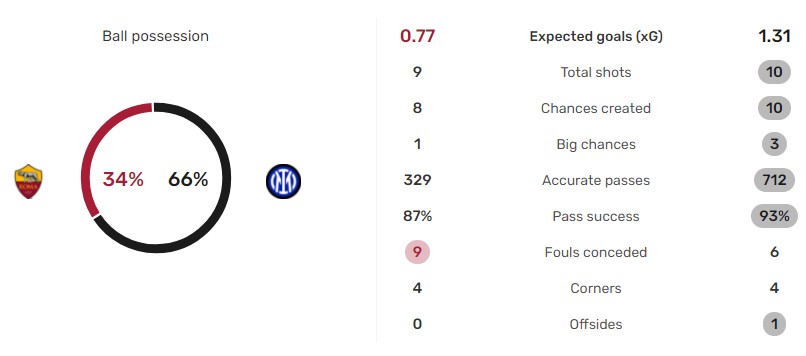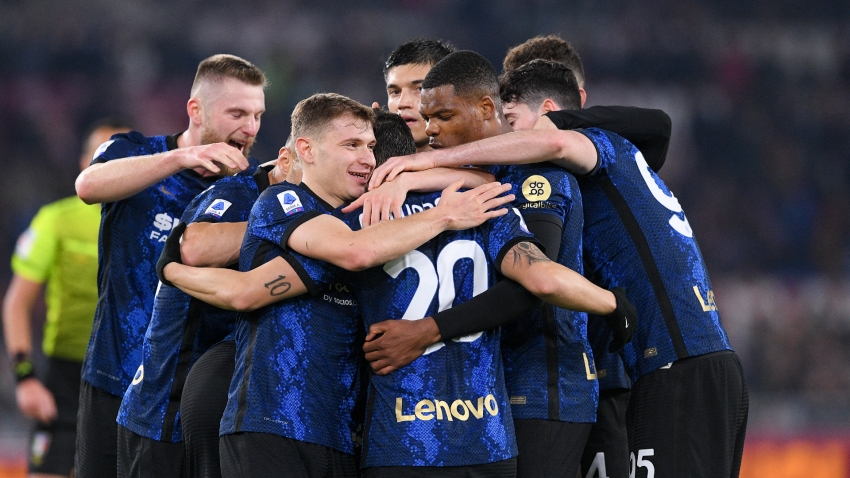In Round 15 of Serie A, one of the key battles took place on Saturday night as Roma hosted Inter, who were looking to extend their domestic winning streak to four matches.
The game marked Jose Mourinho’s return to face his old club, with whom he won an unprecedented treble back in 2010. The Portuguese manager has had a mixed start to his life in Italy’s capital as the Giallorossi have fallen out of the top six in recent weeks.
Inter, on the other hand, have picked up some serious momentum in the last couple of weeks, winning five of their last six Serie A games.
The following tactical analysis will break down the key patterns of play for both teams and explain the intricacies of their tactical approach to the game.
Team Lineups and Formations

As for the teams’ lineups, both managers kept the same tactical formations they have used so far this season. Both Roma and Inter lined up in a 3-5-2 shape, cancelling each other out to some extent at first glance, but as was evident in the game, especially in the first half, the Nerazzurri were far superior in executing their game plan in this system.
The way Simone Inzaghi had Inter play was not much different from how they have been performing so far this season. Two wing-backs in Denzel Dumfries and Ivan Perisic were key figures in Inter’s attacking play, while Edin Dzeko often dropped into midfield to link-up with the midfielders.
Mourinho also mainly emphasised wing play, especially the left flank and left inside half-space. Matias Vina was the most active of the two wing-backs, finding himself in advanced positions on the right wing. Bryan Cristante operated as a holding midfielder, allowing Jordan Veretout and Henrikh Mkhitaryan to push further forward.
Tactical Analysis – Inter
Inter took care of the business in the first 40 minutes of the game, scoring three goals from four shots on target, with no reply from Roma. They took their chances with incredible precision, as shown by the xG metric, which was 0.90 from play. Overall, Inter were in control of the game from the first minute and averaged 70% possession in the first half. The Nerazzurri were less dangerous in the second half, scoring only 0.41 xG, but that was not a big deal with a three-goal lead.
As mentioned above, Inter wanted to build their game mainly through the flanks. We can see that in the picture below. Inter’s three centre-backs are spread across the entire width of the pitch, with Brozovic dropping in between Danilo D’Ambrosio and Milan Skriniar. The wide positioning of the two centre-backs allowed the two wing-backs, Dumfries and Perisic, to move up high and play almost like wingers.
Roma’s midfield block focused on maintaining a compact space between the defensive and midfield lines, with only the two strikers applying pressure on Inter in the first phase. However, this approach allowed Inter to easily build up their positional play in the first phase and at times have a 4 v 2 or even a 5 v 2 numerical superiority.


![]()

From the first minute of the game, it was clear that Mourinho had set his team up to defend with a 5-3-2 block. This approach made it difficult for Roma to impose themselves on Inter, as the home side had no chance against the champions in the possession game in the first half. They accumulated just 0.77 xG in the entire match, 0.22 of which came from set-plays.
Although Roma lined up in an identical 3-5-2 formation to Inter, some of the tactical nuances they implemented in terms of player positions were different. As we can see in the picture below, Roma’s three centre-backs start the build-up play, while the two full-backs are slightly further up the pitch. Importantly, Inter were more aggressive in their pressing than Roma in this game, allowing Mourinho’s men 9 passes per defensive action (PPDA) compared to Roma’s 15.
Inter often pressed with three players in the front line, meaning Roma had no numerical superiority. Roma’s plan was to find a way to play the first pass through the lines into the midfield area, where they had superior numbers against Inter. However, if one of the centre-backs was unable to play a pass into midfield, they were simply forced to go long to avoid losing possession in their own defensive third.

This caused Roma problems throughout the game as they could only play 54 passes into the final third. The home team only enjoyed possession when Inter retreated into the middle block, giving Roma more time and space to build their game from the back. In those instances, Roma attacked mainly through the inside lanes and wide spaces, playing vertical passes for a striker to run between Inter’s centre-back and wing-back.

When the ball entered the final third, the striker would run onto the ball in the wide channel, drawing Inter’s wide centre-back with him, creating a gap in the back line for the Roma midfielder to exploit with a run from deep. This was usually followed by a cut back pass into the penalty area for the incoming player to take a shot on goal.

Expected Goals (xG) Statistics


